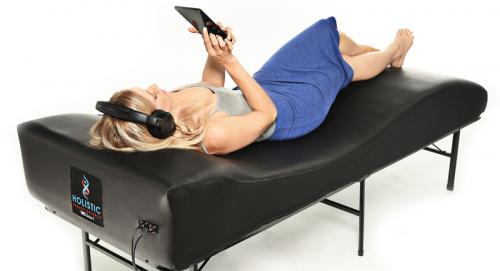Using Vibroacoustic Sound Therapy for Sleep Disorders: A Path to Peaceful Sleep

Sleep is a fundamental pillar of our well-being, and its quality profoundly influences our daily lives. Unfortunately, sleep disorders, such as insomnia, restless leg syndrome, and sleep apnea, plague a significant portion of the population. In the quest for better sleep, many have turned to alternative therapies, one of which is Vibroacoustic Sound Therapy.
Sleep disorders encompass a range of conditions that interfere with the regular sleep cycle. These issues can manifest in various ways, from difficulty falling asleep (insomnia) to disrupted sleep patterns (sleep apnea) and uncomfortable sensations in the legs (restless leg syndrome). Such disorders can significantly impact one's daily life, leading to fatigue, irritability, and a decline in overall health.
The Power of Vibroacoustic Sound Therapy
Vibroacoustic Sound Therapy is a holistic approach that combines the healing power of sound and vibration. It is designed to synchronize the body with specific frequencies and rhythms, offering a multitude of physical and mental health benefits. When it comes to sleep disorders, this therapy offers several advantages:
Stress Reduction: One of the most common culprits behind sleep disorders is stress. Vibroacoustic Sound Therapy has the remarkable ability to induce deep relaxation. The gentle vibrations and soothing sounds create a calming environment, reducing stress and anxiety, which can significantly improve one's ability to fall asleep.
Pain and Discomfort Relief: Those with sleep disorders often struggle with physical discomfort that hinders sleep. Vibroacoustic Sound Therapy can target specific areas of discomfort, such as muscle tension or joint pain, through focused vibrations. By addressing the physical pain, this therapy can make it easier for individuals to fall asleep and stay asleep.
Cognitive Calm: Racing thoughts and an overactive mind are common challenges for people with sleep disorders. The soundscapes in sound therapy can help quiet the mind, allowing individuals to let go of intrusive thoughts and worries. As the mind becomes more tranquil, falling asleep becomes more attainable.
Promotion of Sleep Cycle Regulation: Vibroacoustic Sound Therapy can help regulate the sleep cycle. By promoting the production of melatonin, the hormone responsible for sleep, and synchronizing the body's natural rhythms, this therapy aids in achieving a consistent sleep pattern.
Sensory Distraction: For some individuals, sleep disorders are aggravated by external disturbances or noise. Vibroacoustic Sound Therapy can act as a sensory distraction, drowning out disruptive sounds and creating a serene sleep environment.
Case Studies and Personal Testimonials
Several individuals who have struggled with sleep disorders have reported positive outcomes from incorporating Vibroacoustic Sound Therapy into their routine. Many have experienced a significant improvement in their ability to fall asleep and enjoy a full night's rest. These personal testimonials underscore the potential of this therapy in addressing sleep-related issues.
Conclusion
For those grappling with sleep disorders, the search for effective solutions can be a long and often frustrating journey. Vibroacoustic Sound Therapy presents a promising path to better sleep quality. By reducing stress, alleviating discomfort, calming the mind, regulating the sleep cycle, and providing sensory distraction, this holistic approach can significantly improve the sleep experience. While it may not be a one-size-fits-all solution, it's certainly worth exploring for individuals seeking a natural and non-invasive way to combat sleep disorders and achieve restful nights. For the best Addiction Rehab Solutions – choose TheSoundWell Corp.
Key Takeaways
Sleep Disorders Are Common: Sleep disorders, such as insomnia, sleep apnea, and restless leg syndrome, affect a significant portion of the population, leading to fatigue and reduced overall health.
Vibroacoustic Sound Therapy: Vibroacoustic Sound Therapy is a holistic approach that combines sound and vibration to promote relaxation and well-being. It has potential benefits for improving sleep quality.
Stress Reduction: This therapy can reduce stress and anxiety, which are common contributors to sleep disorders, creating a more conducive environment for falling asleep.
Pain and Discomfort Relief: For individuals with sleep disorders characterized by physical discomfort, sound therapy can help alleviate these sensations, making it easier to sleep.
Cognitive Calm: Vibroacoustic Sound Therapy can calm a racing mind, helping individuals let go of intrusive thoughts and worries that hinder sleep.
Regulation of Sleep Cycles: The therapy can help regulate the sleep cycle, promoting the production of melatonin and synchronizing the body's natural rhythms for a consistent sleep pattern.
Sensory Distraction: It can act as a sensory distraction, drowning out disruptive sounds and creating a serene sleep environment.
Personal Testimonials: Many individuals have reported positive outcomes from incorporating this therapy into their sleep routine, indicating its potential for addressing sleep-related issues.
Holistic and Non-Invasive Approach: Vibroacoustic Sound Therapy offers a non-invasive and holistic approach to improving sleep quality, making it a valuable option for those seeking natural solutions to sleep disorders.







Comments